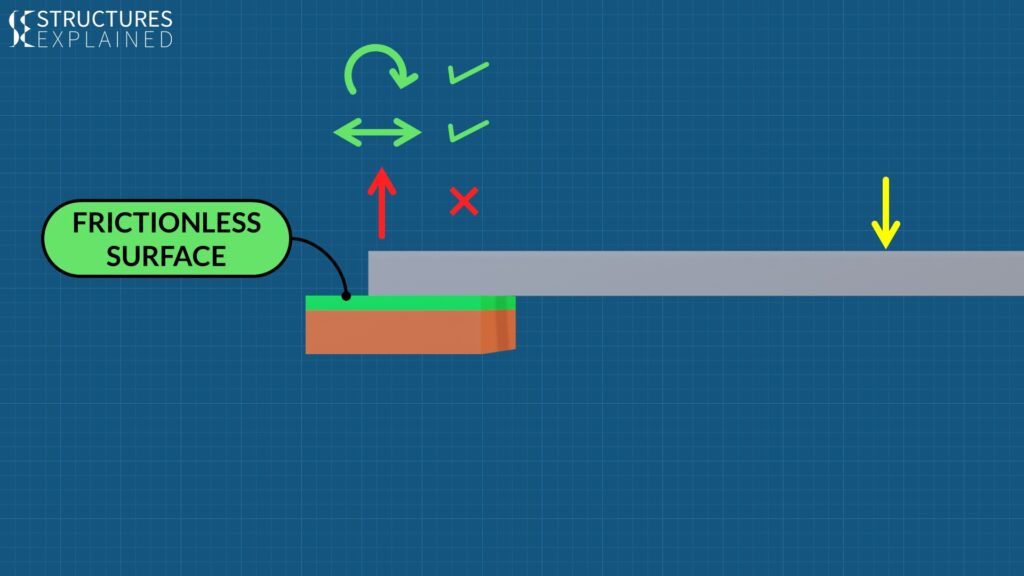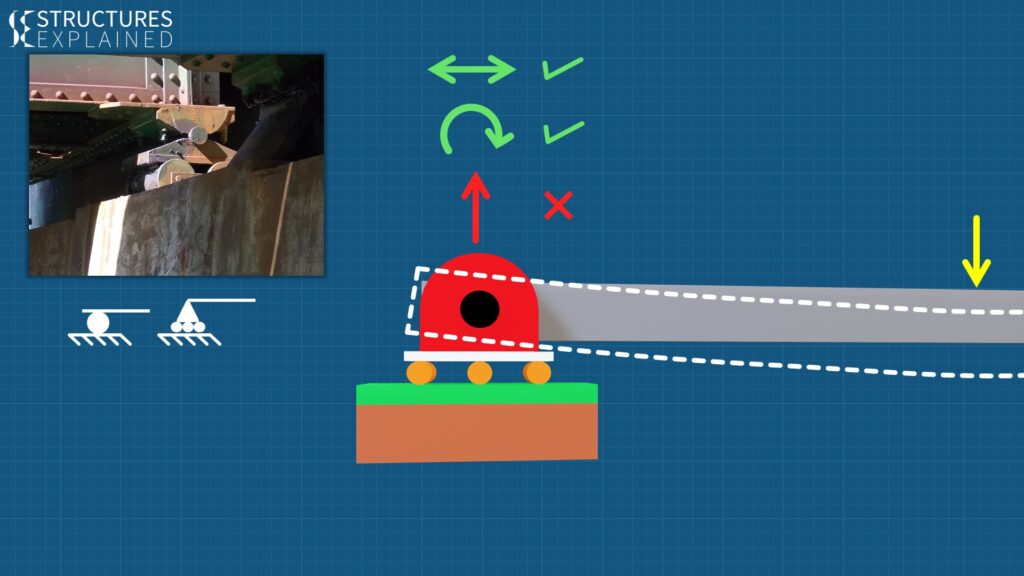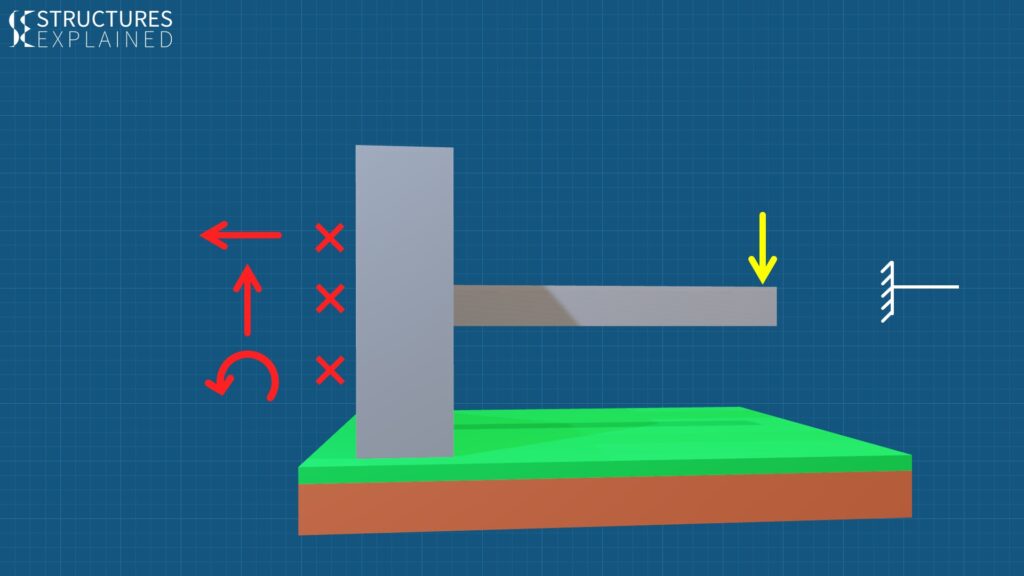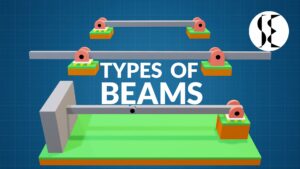In this post we will be learning about types of supports used in beams and reactions produced in them on loading. In engineering mechanics supports are basically of 4 types. Simple support, Roller support, Pin support and fixed support. When the beam is loaded these supports resist the load by producing reaction. These supports allow or resist vertical reaction, horizontal reaction or a moment depending on type of support. Let us have a look at them one by one.

First let us understand what a reaction is. Let us consider a block of concrete lying on the ground. In this arrangement, the block is applying a force of mass times acceleration to the ground. In return, the ground applies equal and opposite force as per Newton’s third law of motion. This force is called Reaction.
Now let us see various types of supports and the reactions they generate when applied by force.
Simple Support

First we will see a simple support. In this support the structural member simply rests on an external frictionless surface. This kind of support allows rotation and horizontal movements but not vertical motion. Hence, it produces only one reaction to the applied force which is perpendicular and away from the surface.
Roller Support

Next we will see Roller Support. This support has wheels on the bottom and a hinge to attach members in it. The surface can be horizontal, vertical, or sloped at any angle. While assuming this support in calculations, all surfaces and the hinge are assumed to be frictionless.
This kind of support allows lateral movement and rotation but does not allow vertical motion. Hence, it just produces a vertical reaction to the force applied. Value of moment will be zero at roller support as it allows rotation. A roller support is generally represented in mechanics with a triangle having circles below it or just a circle. This kind of support is found in large bridges, which allows thermal expansion and contraction of the bridge.
Pinned Support

Next comes pinned support. This support is fixed at the bottom and has a hinge to attach members in it. The surface to which support is attached can be horizontal, vertical, or sloped at any angle.
This kind of support allows only rotation and restricts horizontal and vertical movements. Hence, it produces two reactions to the applied force. One in horizontal direction and other in vertical direction. Value of the bending moment will be zero at pin support as it allows rotation. Pinned support is generally represented in mechanics with just a triangle. This kind of support is also found in bridges and trusses.

So, will the pin or roller support always allow rotation? The answer is, not necessarily. If the roller or pin support act as intermediate support in a continuous beam, then it will resist the rotation. In the above illustration the continuous beam is loaded uniformly. Dashed lines show the deflected shape of the beam where end supports allow rotation but middle support resists the rotation. Hence zero moments at ends and some value of moments in the middle.
Rigid or Fixed Support

Next we will see rigid or fixed support. This kind of support restricts any kind of motion hence we have all 3 reactions which are horizontal reaction, vertical reaction and a moment. This type of connection is used in concrete framed structures or in this case a cantilever beam. They are represented as a single line for structural members and a hatched vertical line for fixed support.
Watch in video form.






Pingback: sildenafil us pharmacy
Pingback: best essay services
Pingback: i need help writing an argumentative essay
Pingback: need help in writing an essay
Pingback: essay paper writing services
Pingback: the best essay writer
Pingback: essays online to buy
Pingback: good essay writers
Pingback: mba application essay writing service
Pingback: how to write my college essay
Pingback: cambridge essay service
Pingback: national junior honor society essay help
Pingback: essays writing service
Pingback: law school essay writing service
Pingback: where can i buy essays online
Pingback: the help essay on racism
Pingback: generic cialis best pharmacy
Pingback: hrt online pharmacy
Pingback: chloramphenicol eye drops pharmacy
Pingback: no prescription online pharmacy hydrocodone
Pingback: pharmacy that carry oxycodone
Pingback: does cialis make you harder
Pingback: viagra 100 mg canada
Pingback: cialis professionals
Pingback: cialis pharmacy
Pingback: generic cialis vs brand cialis reviews
Pingback: sildenafil india buy
Pingback: where can you buy viagra pills
Pingback: generic viagra cheap
Pingback: viagra original
Pingback: cheapest cialis on the web
Pingback: erectivin vi non prescription tadalafil reviews
Pingback: canadian online pharmacy cialis
Pingback: amlodipine pharmacy prices
Pingback: viagra overseas pharmacy
Pingback: best seller cialis
Pingback: best female viagra pills in india
Pingback: cialis no perscription
Pingback: viagra tablets in india online
Pingback: Hyzaar
Pingback: adcirca tadalafil
Pingback: sildenafil 100 no prescription
Pingback: can you buy viagra online legally
Pingback: viagra online in usa
Pingback: viagra 50mg price in india
Pingback: viagra pills price in india
Pingback: where can you buy viagra over the counter in canada
Pingback: take cialis the correct way
Pingback: tadalafil tablet
Pingback: canada pharmacy cialis
Pingback: how long does it take cialis to start working
Pingback: neurontin amitriptyline
Pingback: metronidazole assay
Pingback: alcohol with sulfamethoxazole
Pingback: lyrica for depression
Pingback: valtrex ointment
Pingback: rosemary tamoxifen
Pingback: glucophage intolerance
Pingback: furosemide 500mg
Pingback: lisinopril 2omg
Pingback: Keyword Tool Pro provides search volume data for English keywords.
Pingback: do rybelsus side effects go away
Pingback: forgot to take rybelsus
Pingback: veillonella metronidazole
Pingback: increasing zoloft dosage from 100 to 150
Pingback: gabapentin austauschpräparat
Pingback: lexapro versus zoloft
Pingback: a patient asks the nurse how long it will take for escitalopram to be completely effective. quiz
Pingback: is duloxetine a narcotic?
Pingback: sildenafil gel uk
Pingback: cephalexin food interactions
Pingback: cymbalta and nyquil
Pingback: alternatives to fluoxetine
Pingback: keflex generic names
Pingback: ciprofloxacin and dexamethasone combination ear drops
Pingback: side effects of cephalexin in adults
Pingback: bactrim oral dose for uti
Pingback: allergic reaction to bactrim
Pingback: can i take amoxicillin with ibuprofen
Pingback: what does diltiazem do
Pingback: unable to climax on effexor female
Pingback: citalopram trade name
Pingback: cozaar reviews
Pingback: flomax and urinary retention in women
Pingback: rosuvastatin and ezetimibe
Pingback: augmentin dose for sinus infection
Pingback: generic for flexeril
Pingback: diclofenac sodium side effects
Pingback: depakote er side effects
Pingback: contrave 8/90
Pingback: ddavp and dialysis
Pingback: aspirin and covid vaccine
Pingback: how to pronounce aripiprazole
Pingback: allopurinol side effects liver
Pingback: amitriptyline doses
Pingback: buspar vs xanax
Pingback: celexa ingredients
Pingback: augmentin while pregnant
Pingback: baclofen euphoria
Pingback: celebrex side effects
Pingback: ashwagandha near me
Pingback: celecoxib generic price
Pingback: what is bupropion for
Pingback: protonix alternative
Pingback: does semaglutide need to be refrigerated
Pingback: repaglinide process
Pingback: actos iniciales
Pingback: does robaxin make you sleepy
Pingback: does abilify give you energy
Pingback: sleeping pill remeron
Pingback: prezzo acarbose
Pingback: stromectol for humans
Pingback: tizanidine withdrawal
Pingback: does voltaren have carbs
Pingback: venlafaxine high
Pingback: synthroid hemorrhoids
Pingback: spironolactone transgender
Pingback: tamsulosin sildenafil interaction
Pingback: sitagliptin severe adverse effects
Pingback: maxalt online pharmacy
Pingback: is it ok to take 100mg of sildenafil
Pingback: cialis online pills
Pingback: tadalafil how long to take effect
Pingback: cheap levitra online
Pingback: mexican xanax pharmacy
Pingback: cialis vs levitra
Pingback: sildenafil pills
Pingback: best viagra price in india
Pingback: ivermectin stromectol
Pingback: generic ivermectin cream
Pingback: ivermectin goodrx
Pingback: tadalafil sunrise
Pingback: ivermectin medication
Pingback: cheap generic viagra no prescription
Pingback: sildenafil and vardenafil
Pingback: stromectol tablets 3 mg
Pingback: ivermectin 3 mg dose
Pingback: vardenafil pills
Pingback: maxim peptide tadalafil review
Pingback: how long does augmentin stay in your system
Pingback: gabapentin withdrawal timeline
Pingback: lyrica 100 mg
Pingback: doxycycline sun exposure
Pingback: problems with provigil
Pingback: is amoxicillin good for sinus infection
Pingback: how long does nolvadex take to get rid of gyno
Pingback: lisinopril pregnancy category
Pingback: ampicillin tartalmú antibiotikumok
Pingback: what is keflex used to treat
Pingback: cephalexin for uti dosage
Pingback: what pain reliever can i take with trazodone
Pingback: how to stop diarrhea from metformin
Pingback: goodrx valacyclovir
Pingback: ciprofloxacin hydrochloride ophthalmic solution
Pingback: viagra india online pharmacy
Pingback: tadalafil 10mg reviews
Pingback: how long is viagra effective
Pingback: vardenafil citrate 20 mg
Pingback: sildenafil 20 mg para que sirve
Pingback: sildenafil citrate side effects
Pingback: sildenafil citrate tablets
Pingback: sildenafil dosage
Pingback: generic viagra sildenafil
Pingback: tadalafil how long does it take to work
Pingback: ziphealth cialis
Pingback: levitra vs viagra vs cialis
Pingback: vardenafil (levitra)
Pingback: unicare pharmacy dublin artane castle
Pingback: tadalafil lower blood pressure
Pingback: sildenafil dose for erectile dysfunction
Pingback: mail order levitra
Pingback: order levitra online no prescription
Pingback: online pharmacy viagra india
Pingback: online pharmacy selling valium
Pingback: bupropion hcl xl global pharmacy
Pingback: sildenafil 20 mg tablet price
Pingback: cialis 20mg side effects
Pingback: vardenafil hcl generic
Pingback: sildenafil dosing
Pingback: best online cialis pharmacy
Pingback: dollar store drug test
Pingback: flomax online pharmacy
Pingback: can i buy viagra from a pharmacy
Pingback: does tadalafil keep you hard after coming
Pingback: target pharmacy effexor
Pingback: difference between sildenafil and tadalafil
Pingback: can tadalafil lower blood pressure
Pingback: where to buy vardenafil in the united states
Pingback: what is tadalafil used for
Pingback: tadalafil and blood pressure
Pingback: online pharmacy florida
Pingback: carbamazepine brands india
Pingback: tegretol prior to surgery
Pingback: dosage chart for motrin by weight
Pingback: celecoxib drug card
Pingback: gabapentin ruined my life
Pingback: homöopathische mittel ibuprofen
Pingback: celebrex encyklopedia leków
Pingback: gabapentin groggy
Pingback: sulfasalazine retail price
Pingback: etodolac vs ibuprofen
Pingback: how to wean off amitriptyline
Pingback: can i take imodium with mebeverine
Pingback: cilostazol in romania